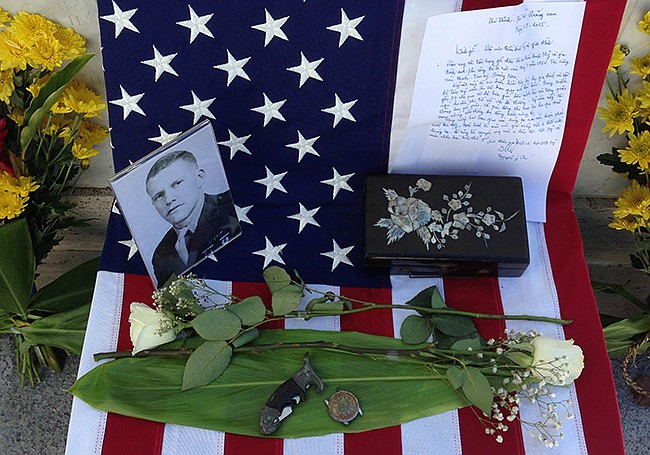- April 25, 2024
-
-
Loading

Loading

The long search for the remains of a fallen U.S. Marine has recently ended in the city of culture and heritage – and it all started with a watch and a knife.
On May 13, Student Media Advisor Jay Hartwell of the University of Hawaii at Manoa was contacted with a unique opportunity: an endeavor to find the gravesite of Vietnam War veteran Capt. John Sherman.
Vietnam Television International was filming a documentary about the Vietnam War, and how the returning of artifacts from the war can bring healing and reconciliation.
Two such artifacts belonged to Sherman: an old folding knife and a wristwatch missing the straps. They were picked up by Vietnamese soldier Chi Nguyen, who discovered the body of the U.S. Marine pilot after he was shot down over Vietnam.
After burying the remains of Sherman in a makeshift grave, Nguyen kept the knife and watch for decades before deciding it was finally time to give them back.
Vietnam Veterans of America had been looking to return those artifacts, but Sherman’s gravesite – as well as his family’s whereabouts – remained unknown. The National Memorial Cemetery of the Pacific in Honolulu still lists Sherman's name at the Court of the Missing for the Vietnam War.
Hartwell was asked to help uncover the mystery because of his prior experience as a journalist, one used to unraveling a mystery on deadline.
“They were trying to track down this one soldier who they thought was buried in Honolulu at our national memorial cemetery,” Hartwell said. “They asked me if I could help them out. They weren’t having any luck.”
Hartwell’s search ironically started where it would all end: Winter Park. A Google search revealed a Vietnam memorial website that listed Sherman’s remains as buried in Glen Haven Memorial Park, located within the northeast limits of the city.
Hartwell contacted the cemetery only to hit a snag.
“They didn’t have any record of John Sherman being buried there,” Hartwell said. “They had maybe a dozen Shermans that had been buried there.”
From that point Hartwell slowly unraveled the mystery, piecing together the life of a man that only started as a name.
John Brooks Sherman was born in on Jan. 30, 1940, growing up in Shaker Heights, Ohio. He graduating from Brown University in Rhode Island in 1962 and was immediately commissioned by the U.S. Marines.
“This was clearly somebody who loved life,” said Hartwell, who spoke with several of Sherman’s former classmates from Brown University to delve deeper into the missing Marine. “He was captain of soccer team in senior year and he had a reputation according to one of his classmates of being aggressive on the soccer field.”
Sherman later joined the battle overseas in Vietnam and was shot down on March 25, 1966.
His body had remained in its makeshift grave near the crash site until it was found by a U.S. recovery team in 1993. But where it was buried after that remained a mystery.
One of Sherman’s classmates remembered him having a younger brother, Stephen Sherman. A library staffer at Brown University found his parents’ names: Allan and Mary.
That information would turn out to be the final missing piece to the puzzle. The Defense POW/MIA Accounting Agency in Hickam Field, Hawaii revealed that Sherman’s remains had been turned over to an Orlando mortuary in 1998.
Records from University School, a prep school in Shaker Heights, also confirmed that Sherman’s mother had relocated to Winter Park in 1963 after her husband had passed away.
The answer – the location of Sherman’s final resting place – had been under their nose all along.
Sherman had been buried with his parents.
“Sure enough, we found the name under the mother’s name,” Hartwell said. “That plot had been put together by the brother, who apparently died last November. We came full circle back to Glenn Haven.”
Sherman’s knife and watch were turned over to Vietnam Veterans of America during a formal ceremony earlier this year, enclosed with a letter from Nguyen. Since Sherman has no surviving family members that have been located, Sherman’s classmates and the VVA agreed that the items should be passed on to Brown University, who has an archive for alumni veterans.
The artifacts turned out to be powerful tools of healing, Hartwell said.
“It made me realize that there’s a large story here, that the work to return these artifacts to help mend some of the emotional and psychological wounds of the war is very important work,” Hartwell said. “While the artifacts themselves – a knife and a watch – may not seem like much, they were very meaningful to the classmates of Capt. Sherman and to the local Honolulu affiliate of Vietnam Veterans of America.”
“To be part of that process and to help with that healing was probably the most profound part of being involved.”
In the process of searching for Sherman’s remains, Hartwell learned about an American soldier he would describe as “fearless.” Sherman had already made a decision early on to join the Marines based on his ROTC enrollment, he said
“This was one of those people who was not afraid and was willing to serve,” Hartwell said. “A fighter pilot in active war is probably one of the riskiest positions you could take.”
“When you look at a picture of this guy, you don’t see the smile that his friends remembered from the fraternity or the soccer field. You see a guy who appears to be fearless.”
Director of Communications Mokie Porter of the Vietnam Veteran of America office in Maryland said the VVA plans to turn over the knife and watch to Brown University during an official ceremony in the near future.